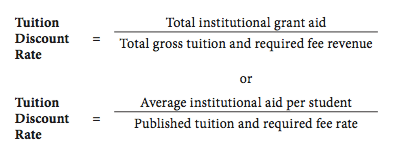The is the second chapter of my series that breaks down the primary issues of private higher education in the United States. For some background on me and where I'm coming from for this series, check out chapter one or this historical account posted last week.
One of the fundamental changes in higher education over the past 30 years was a transition to a traditional business model, i.e., the commodification of education has resulted in competition between institutions both public and private. As a result, the emphasis went from quality education and intellectual curiosity to enrollment; get them in the door and then keep them there.

For any who've worked in a college admissions office, you've seen what this can mean: quotas, corporate sales strategies, and unrelenting customer service. These quotas are often determined from the top down wherein the institution's president or VP of Enrollment Management decide on an overall admissions goal. While some institutions develop this goal based on market research, demographic trends, and the institution's ability to serve students, other institutions develop goals arbitrarily. I personally witnessed heated debates between a VPEM and president over 10 students with no rationale behind figures other than the VP trying to avoid working their people into the ground.
Once settled, the admissions goal is then divided up amongst recruiters. These poor chaps are assigned goals at different points of the funnel that breaks down largely as follows: visits, calls, inquiries, campus tours, applications, deposits, registrations, housing deposits, and ultimately conversion (they show up and last through the all-important week 3). This might sound perfectly manageable, but bear in mind that recruiters visit high schools and camps where they must maintain relationships with teachers and counselors. They often have to travel throughout their assigned region, which can be local, regional, national, and/or international*. Once fall travel season ends, it's all about pushing students through the funnel to conversion. Many recruiters spend spring and summer on call 24/7 answering inquiries from students in the funnel and chasing those who've stopped engaging and might be falling out. This also includes negotiating with students who rightly position institutions against each other, making them compete by leveraging their discount rate.
Many who attend college assume that financial aid is a simple-yet-convoluted process that starts with the FAFSA and ends with a mysterious package that they're stuck with for most of their college career. What they don't realize is that that package is based just as much on an institution's discount rate as it is on their FAFSA and family contribution. College CFOs are the guardians of the discount-rate calculation that determines how much wiggle room recruiters have to essentially buy a student's admission.

C/O Baum, Sandy; Lapovsky, Lucie "Tuition Discounting: Not Just a Private College Practice"
When you see a college's tuition, it is more important to look at its discount rate than the overall tuition because the latter is based more on the institution appearing expensive than the actual cost of the education. These discount rates balance institutional aide with tuition revenue, meaning that colleges can only give so much and giving is based more on recruiting savvy students/parents than it is on students' actual financial need. There is a ongoing debate in higher education on what to do about the increasing need to recruit higher-paying students who know enough to negotiate, i.e., leverage discount rate and aide, with the academy's obligation (and they know it's an obligation) to make college accessible and affordable for low-income/first-generation students.
Some colleges took the brave step of abandoning discount rates and instead based their tuition on actual dollars spent, which is essentially "no-haggle" pricing for an education. While noble, I'm sorry to say that every one of these institutions closed due to dramatic decreases in enrollment. Simply put, in the recruiting process, people care more about getting a deal than they do about affordability. They'll pay more for an inflated education, even when it's not in their best interest.

We all know how this ends. Students who fell victim to aggressive sales tactics and believed they were getting a deal end up taking out more student loans and are tied to an institution that they can't afford. Recruiters will go to great lengths to ensure this, including enrolling blind or quadriplegic students at an arts college**.
My next chapter will focus on retention and some of the internal challenges colleges face to keep butts in seats. Throughout this series, I'd love to answer any questions you have and will do my best to address them future posts or create an AMA. So with that, what would you like to know?
*in the 90's, there was a significant push for international recruitment as foreign students are ineligible for federal aid, thus was born the myth of the "full-pay student." The assumption was that foreign students would pay the full tuition and while that might have been true at first, the wonders of the internet meant that foreign students could research institutions' pricing models and then play institutions against each other. As a consequence, foreign students received institutional grants and scholarships traditionally reserved for domestic students.
**I believe education should be accessible for all, but to charge $35,000+/year to a student with physical disabilities that directly impede their ability to progress in a curriculum is ethically abhorrent, especially in environments where faculty can (and will) outright refuse to help them. There are many people with disabilities who are successful artists, but to charge that much money for them to become one is wrong.
Nice and clean once the picture picture, please help him to follow behind @yudisb07. thank you
Due to these problems, higher ed. just may implode on itself in the near future. It's a ticking time bomb.
I'll get into the various reasons as to why you're right later in the series. Some will adapt and survive, but most will shut their doors within the next 20 years.